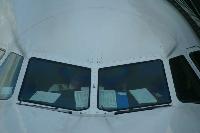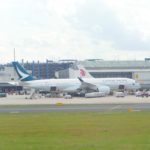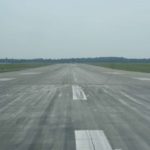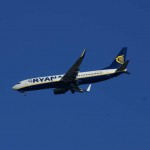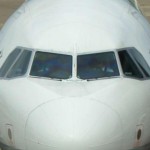The Board of Directors of Air France-KLM, chaired by Jean-Cyril Spinetta, convened on 18th November 2009 to examine the accounts for the First Half of Financial Year 2009-10.
Roissy/ Amstelveen – Commenting on the activity, Pierre-Henri Gourgeon, Chief Executive Officer, said: “Since the start of the crisis we have responded quickly and we are adapting more rapidly than expected to the environment. We have sharply reduced our capacity in both passenger and cargo. At the same time we have reduced our costs. Our cost-savings program is regularly updated and since the beginning of the financial year we have increased our objective by 100 million euros to around 700 million. All these measures are starting to have a positive impact on our results. After deep losses in the First Quarter, the Second was close to break-even despite the lack of recovery in unit revenues and a charge of 179 million euros relating to the pre-2009 fuel hedges. We are stabilizing our activity levels, and therefore reducing headcount within the group. We are proposing a voluntary redundancy program at Air France involving 1,700 jobs, which will be effective in 2010.
Lack of visibility over the timing and strength of the economic recovery means we must pursue our efforts in terms of cost reduction. Our objective is to return to operating break-even, excluding the impact of the pre-2009 fuel hedges, by the beginning of the next financial year.”
Key data
|
€ millions (per share data in €) |
Second Quarter to 30 September |
First Half to 30 September |
||||
|
2009 |
2008 [2] |
Change |
2009 |
2008 2 |
Change |
|
|
Revenues |
5,606 |
6,940 |
(19.2)% |
10,775 |
13,445 |
(19.9)% |
|
EBITDAR |
555 |
1,012 |
(45.0)% |
667 |
1,826 |
(63.5)% |
|
Operating income/(loss) |
(47) |
391 |
nm |
(543) |
592 |
nm |
|
Adjusted1 operating income / (loss) |
15 |
445 |
nm |
(419) |
701 |
nm |
Net income/(loss), group share |
(147) |
27 |
nm |
(573) |
176 |
nm |
|
Restated net income/(loss)[3] |
(95) |
238 |
nm |
(509) |
359 |
nm |
|
Earnings/(loss) per share |
(0.50) |
0.09 |
nm |
(1.95) |
0.61 |
nm |
|
Diluted earnings/(loss) per share |
(0.50) |
0.09 |
nm |
(1.95) |
0.58 |
nm |
Second Quarter close to break-even at the operating level
Ongoing reduction in capacity
Capacity reduction was pursued in the Second Quarter. Passenger capacity was reduced by 4.4%, exceeding the drop in traffic of 3.3% and leading to a 0.9 point improvement in load factor to 84.0%. The trend in unit revenues was similar to the First Quarter, with a still marked deterioration in premium. In total, unit revenues per available seat kilometer (RASK) declined by 13.6%. Passenger revenues amounted to 4.34 billion euros (-17.2%). An improvement in volumes combined with a significant reduction in operating costs helped the passenger business to achieve an operating result close to break-even (-15 million euros), and positive excluding the impact of pre-2009 fuel hedges.
The cargo load factor gained almost one point to 64.5% on the back of a 17.9% reduction in capacity and a 16.8% drop in traffic. The deterioration in unit revenues bottomed out, with a 27.8% drop in revenue ton kilometer versus -30.0% in the First Quarter. Revenues declined 40.5% to 571 million euros. Operating costs were strongly reduced, but not sufficiently to offset the decline in revenues. Cargo remained deeply in the red with an operating loss of 147 million euros in the Second Quarter.
Total group revenues amounted to 5.61 billion euros (-19.2%). Operating costs were reduced by 13.6% to 5.65 billion euros thanks to the 202 million euros in cost savings realized under the ‘Challenge 12’ program. Excluding fuel they declined by 9.5%.
Unit costs reduced
Although production measured in equivalent available seat kilometers (EASK) fell by 6.9%, unit cost per EASK was reduced by 8.2%.
All cost items contributed to the reduction:
· The fuel bill declined by 438 million euros to 1.30 billion euros (-25.3%) under the combined effect of a 9% drop in volume, a negative currency effect of 8% and a fuel price reduction limited at 23% by the effect of the hedges.
· Employee costs were down by 2.1% to 1.81 billion euros. Excluding the additional contribution of
44 million euros to the Air France and KLM pension funds, the decline would have been 4.4%.
· Marketing and distribution and other costs fell by 25.6% and 13.6% respectively.
.
The operating loss amounted to 47 million euros. Excluding the negative impact of fuel hedges of 179 million euros, the operating result would have been a profit of 132 million euros. Adjusted operating income amounted to 15 million euros at 30th September 2009, and 194 million euros excluding the negative impact of fuel hedges.
The operating income excluding fuel hedges was broken down as follows:
– Passenger business: +140 million euros (-15 million euros including fuel hedge impact);
– Cargo business: -127 million euros (-147 million euros including fuel hedge impact);
– Other businesses: +81 million euros (+77 million euros including fuel hedge impact);
– Maintenance: +38 million euros.
Net interest charges rose from 11 million euros at 30th September 2008 to 70 million euros at 30th September 2009 on the back of a drop in financial income linked to the lower yield on investments, while the gross interest charge remained stable. Other financial income and costs amounted to +9 million euros against
-441 million euros a year earlier, mainly due to the change in the fair value of hedging instruments.
The pretax loss stood at 183 million euros (-37 million euros a year earlier) and net loss, group share at 147 million euros (versus income of 27 million euros at 30th September 2008). The loss per share (undiluted and diluted) stood at 0.5 euros against earnings per share (undiluted and diluted) of 0.09 euros at 30th September 2008.
First Half
Passenger traffic declined by 4.5% in line with capacity (-4.6%). The load factor remained high at 81.7% (+0.1 point). The decline in cargo traffic (-19.3%) was higher than the reduction in capacity (-17.3%), leading to a 1.6 drop in load factor to 63.9%. In both businesses, unit revenues were sharply down year-on-year.
Total revenues amounted to 10.77 billion euros (-19.9%). Production measured in EASK declined by 7.0%, while unit costs per EASK were down 6.1%. Savings realized under the ‘Challenge 12’ program amounted to 350 million euros.
The operating loss stood at 543 million euros and the adjusted operating loss was 419 million euros after a charge of 430 millions euros relating to the pre-2009 fuel hedges. The net loss, group share stood at 573 million euros against income of 176 million euros at 30th September 2008. Undiluted and diluted loss per share both stood at 1.95 euros against earnings and diluted earnings per share of 0.61 euros and 0.58 euros respectively at 30th September 2008.
Solid financial structure
Investments net of disposals amounted to 572 million euros at 30th September 2009 (versus 997 million euros at 30th September 2008). The group maintained a solid financial position with cash of 4.0 billion euros and available credit lines of 1.2 billion euros. In addition, the group undertook a successful 700 million euro bond issue in October 2009.
Shareholders’ funds stood at 6.03 billion euros, 350 million euros higher than at 31 March 2009, with the negative impact of the fair value of hedging instruments down from 1.5 billion euros to 680 million euros during the period. Net debt stood at 5.62 billion euros versus 4.44 billion euros at 31st March 2009. The gearing ratio1 stood at 0.93 and at 0.84 excluding hedging instruments.
Outlook for the remainder of the year
The group continues to adapt to the economic environment by reducing capacity. In the passenger business, capacity is down 2.0% for the Winter ‘09 season while cargo is also continuing to reduce. At the same time, Air France-KLM continued to adapt headcount accordingly.
The crisis has led to behavioural changes among our customers which are likely to persist beyond the recovery. The group is therefore adapting its air transportation businesses to the new environment. The new ‘Premium Voyageur’ class at Air France, and ‘Economy Comfort’ at KLM complement our long-haul offer with an intermediate product between the premium and economy classes. The overhaul of the medium-haul product is based on ensuring customer needs are better taken account of via the schedule of fares: a simpler and less expensive product for leisure travellers, and a product offering flexibility, time-saving and services at more competitive rates for business travellers. Finally, the cargo business is being restructured based on the optimisation of bellies in the passenger and combi aircraft, and the rationalization of the full freighter program.
All these measures are accompanied by the reorganisation of a number of processes which should lead to the turnaround of the medium-haul business and a return to break-even of the cargo activity during Financial Year 2011-12.
The group has also implemented a new fuel hedging policy, reducing the time span of the hedges from four to two years and the absolute level from two years’ consumption to 80% of a single year of consumption. Based on the forward curve at 13th November 2009, the fuel bill is estimated at 1.8 billion dollars for the Third Quarter to 31st December 2009 and 1.6 billion dollars for the Fourth Quarter to 31st March 2009.
Lack of visibility over the timing and strength of the economic recovery means we must pursue our efforts in terms of cost reduction. Our objective is to return to operating break-even, excluding the impact of the pre-2009 fuel hedges, by the beginning of the next financial year.
Information by business
Passenger
|
|
Second Quarter to 30th Sept |
First Half to 30th Sept |
||||
|
2009 |
2008* |
Change |
2009 |
2008* |
Change |
|
|
Traffic (RPK millions) |
56,141 |
58,042 |
-3.3% |
106,608 |
111,590 |
-4.5% |
|
Capacity (ASK millions) |
66,862 |
69,930 |
-4.4% |
130,440 |
136,671 |
-4.6% |
|
Load factor |
84.0% |
83.0% |
0.9 pts |
81.7% |
81.6% |
0 .1 pt |
|
Total passenger revenues (€ m) |
4,343 |
5,247 |
(17.2)% |
8,357 |
10,184 |
(17.9)% |
|
Revenues from scheduled passenger business (€m) |
4,137 |
5,009 |
(17.4)% |
7,952 |
9,708 |
(18.1)% |
|
Unit revenue per RPK (€ cts) |
7.37 |
8.63 |
(14.6)% |
7.46 |
8.70 |
(14.3)% |
|
Unit revenue per RPK ex currency (€ cts) |
– |
– |
(16.2)% |
– |
– |
(15.9)% |
|
Unit revenue per ASK (€ cts) |
6.19 |
7.16 |
(13.6)% |
6.10 |
7.10 |
(14.2)% |
|
Unit revenue per ASK ex currency (€ cts) |
– |
– |
(15.3)% |
– |
– |
(15.9)% |
|
Unit cost per ASK (€ cts) |
<font size=2 color=black face=Aria |
|||||
…
Picture: Carstino Delmonte/ Touristikpresse.net
